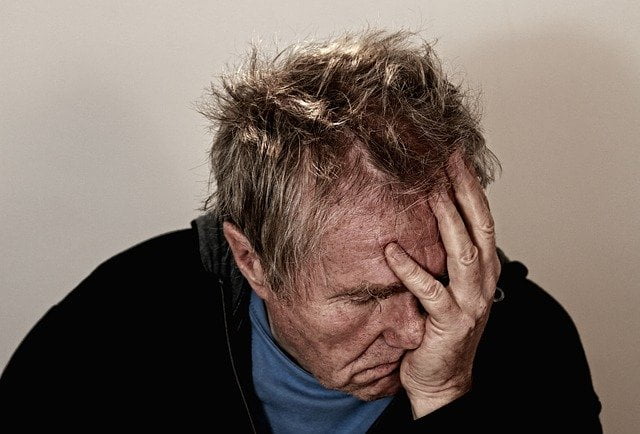Is Cannabis a Depressant?
Given the sheer number of slang terms given to cannabis, including weed, pot, herb, grass, bud, ganja, and Mary Jane, it’s clear how popular this drug has become in modern society.
Originating from Central America and three plants known as Cannabis sativa, Cannabis indica, and Cannabis ruderalis, this psychoactive substance is now grown artificially across the world.
While all types of cannabis [1] start life as plants, they are eventually reshaped and remoulded into various forms: including dried flowers, resinous material known as hash, and a THC oil.
From here, it can be smoked, baked into brownies, or even made into a beverage. It’s this versatility and range of potencies that have contributed to the near cult-like following that cannabis has developed.
So what actually makes cannabis users feel high? It’s a specific chemical present in cannabis plants known as THC, or its longer, less used name, delta-9 tetrahydrocannabinol.
This substance travels through your bloodstream to provide your brain with a host of intoxicating effects: from brief euphoria and hallucinations to intense hunger (known as the munchies), or an overwhelming feeling of sleepiness.
Learn everything you need to know about the nature of cannabis by giving our team a call on 0800 088 66 86
What is a Depressant?

Before unpacking whether cannabis is a depressant, we should first dive into what this term means in the context of drug use.
Also referred to as “downers”, depressant substances [2] make us feel slow and calm, unlike “uppers” such as MDMA or amphetamines.
Depressants produce a mental and physical calming effect by slowing down activity in the Central Nervous System.
This reduces stimulation and causes the user to become less inhibited and more relaxed. Because of their ability to slow brain activity, depressants are commonly used (and misused) to help with various symptoms and health conditions.
For example, barbiturates and benzodiazepines are often prescribed to help treat stress, anxiety disorders, insomnia, and seizures.
When used correctly, they can provide relief from stress-related conditions, and this is because depressants such as benzos increase the activity of GABA: an important neurotransmitter.
Because GABA carries messages from one cell to another, increasing its activity will slow down overall brain function, leading to relaxation.
Find out more about how cannabis can impact your life by calling us on 0800 088 66 86
Cannabis is a Complicated Drug

Answering the question that forms this article is far from simple, as while cannabis is technically a depressant, it’s also a hallucinogen and a stimulant.
For some people, smoking a joint or taking an edible will make them feel drowsy and sap them of all energy. For others, the same drug will give them a sudden energy boost, or cause them to experience hallucinations that briefly change their reality.
So, why is cannabis so difficult to put into a single category, and why do its effects vary from person to person? The answer is a complex mix of genetics, hormones, and the varying chemistry of different weed strains [3].
On one level, our absorption capabilities will vary, and some people will be able to consume more cannabis thanks to their lung capacity, breath duration, and heat rate.
Moreover, our individual genetics influence how our bodies respond to cannabis, and the uptake of THC (the chemical in weed that makes users high) will depend on our unique brain chemistry.
With this in mind, the classification of cannabis varies hugely. It can act as a stimulant, a hallucinogen, or a depressant depending on the person.
It’s partly because of this huge range of experiences that people come back to cannabis use time and time again; the unpredictability keeps it exciting.
To discover every detail about cannabis addiciton for yourself by calling us on 0800 088 66 86
Cannabis as a Depressant

Let’s begin with the focal point of this article: whether or not cannabis is a depressant – to which the answer is yes, it certainly can be.
Smoking weed tends to slow down our brain function so that it operates at a lower speed than normal. Essentially, our neurotransmitters aren’t functioning at the pace that they should be.
This can help relax our muscles and central nervous system, slowing down the body alongside the mind. For many users, this neurological process causes one of two effects: relaxation or low mood.
Feeling relaxed and sleepy is a state that’s commonly attributed to smoking or ingesting cannabis. This occurs because the drug affects a neurotransmitter known as dopamine, a key player in the reward and pleasure centre of the brain.
Often referred to as our main “feel-good hormone”, dopamine helps us feel relaxed, motivated, and even euphoric.
Studies suggest [4] that cannabis’ sedative effects occur due to the drug’s ability to increase dopamine. The feel-good emotions brought about by this dopamine rush make us feel more at ease, and happier in general.
This paired with the decrease in other forms of brain activity causes people to feel drowsy and fall asleep quickly. For this reason, certain cannabis strains such as indicas are often used to help people get to sleep and wind down.
However, the most important thing to note here is that the dopamine release caused by cannabis is pretty short-lived, causing the less desirable effects of depressant drugs to take over.
While smoking weed initially increases dopamine levels, long-term users may experience a decrease in their feel-good hormones whenever they take this drug.
Rather than experience the calming, sedating effects of cannabis, [5] they may instead experience low mood and depressive symptoms. Frequent or higher doses of cannabis can cause unpleasant thoughts, increased anxiety, or paranoid episodes.
Daily cannabis smokers might reach a stage where they experience these effects almost constantly.
This has led many people to wonder if the depressant effects of cannabis can cause mood-related disorders, with popular Google searches including “Has cannabis caused my depression?”
However, while cannabis and depression can accompany one another, there’s no definitive link to suggest the drug directly causes depression.
Instead, people who already suffer from depression might smoke cabbabis to numb these feelings, only to find that their symptoms worsen over time.
On the other end of the spectrum, some cannabis users may appear to have depression because of the drug’s depressive effects, such as fatigue, insomnia, and loss of interest in daily activities.
Think you might need the help of a drug rehab to overcome your cannabis addiction? Give our team a call on 0800 088 66 86
Cannabis as a Stimulant

Cannabis is similar to alcohol in many ways, and one of these is that it has both depressant and stimulant properties. [6]
Despite the fact that many people use cannabis to mellow them out, this unpredictable substance can also elevate mood, heighten alertness, and give us more energy, allowing cannabis to sway into the stimulant drug category.
Unlike depressants, stimulant drugs increase activity in certain regions of the brain which heightens heart rate and blood pressure.
Like other psychoactive drugs, stimulants increase dopamine production and can cause it to build up in the brain. This helps increase attention span and motivation levels, with these mood-boosting capabilities leaving many people wanting more.
Like nicotine, caffeine, and Class A drugs such as cocaine, cannabis can make us feel more focused, talkative, and more at ease in social situations.
As touched upon earlier, research shows that THC can increase our dopamine response, but it can also increase seroton, a chemical messenger that acts as a mood stabiliser.
This speeds up messages between someone’s brain and body, causing a euphoric high.
While cannabis carries fewer risks than other stimulants such as cocaine or amphetamine drugs, it isn’t without its adverse side effects.
Frequent cannabis users who experience the stimulant effects of this drug may feel confusion, panic and increased levels of anxiety.
This can manifest as “the jitters”, a state usually attributed to drinking too much coffee where the individual feels restless and cannot sit still.
Other adverse effects include rapid breathing due to increased heart rate, and dizzy spells that make it difficult to function normally.
Paranoia is another common negative reaction, with users feeling that those around them mean harm or are out to get them in some way.
They might imagine that negative conversations are taking place around them when, in actuality, this is just the paranoia taking its toll. As you’d expect, this can be incredibly detrimental to someone’s mental wellbeing. [7]
Don’t let addiction control your life – get the help you need by calling us on 0800 088 66 86
Cannabis as a Hallucinogen

So, cannabis can have a strong depressant effect for some, a stimulant effect for others, and can also act as a hallucinogen. In fact, smoking weed is often stereotyped as a “trippy” experience, with many people expecting to feel an altered sense of reality when they smoke it for the first time.
Hallucinogens and psychedelic drugs can produce changes in your sensory perception to provide various types of hallucinations. In a broad sense, hallucinations are false perceptions of events, senses, or objects around you – meaning they can be visual or auditory.
Another form of hallucination commonly associated with smoking cannabis is paranoia, which involves a mistaken idea or suspicion.
For instance, a visual hallucination might make you think that your friend has mysteriously turned into an alien, while an auditory hallucination might cause you to hear the buzzing of a spaceship that isn’t really there.
On the other hand, a paranoia-induced hallucination might cause you to believe that your friends or family want to cause you harm.
While less common than its depressant and stimulant effects, cannabis can cause hallucinations. [8] Like stronger psychedelic drugs such as LSD and magic mushrooms, cannabis affects the communication of nerve cells in the brain, which can cause a good or bad trip to occur.
Someone having a good time while experiencing a cannabis hallucinogen might enjoy an altered sense of time or a feeling of floating. They might also see brighter colours and experience heightened sensory perception.
However, a bad trip can also occur, leaving users feeling dissociated, disorientated, and intensely paranoid. They may experience negative or disturbing hallucinations that leave them feeling anxious, stressed, and even scared.
Find your way towards a life free from cannabis by giving us a call on 0800 088 66 86
The Long-term Mental and Physical Effects of Cannabis

Because of cannabis’ depressant effects, regular users are at risk of developing a range of physical and psychological concerns, [9] some of which can impair how well they function day-to-day.
While it’s important to note that cannabis carries some medical benefits, we’re referring here to the frequent use of the drug for recreational purposes.
Various experts have shed light on the long-term health implications of chronic cannabis use, particularly concerning cognitive issues.
Over time, weed can impact parts of the brain that control memory, cognition, attention span, and decision-making.
These were especially worrying among those who started using cannabis earlier on, specifically in their early teens through to adulthood.
These individuals are more prone to suffering lapses in memory and trouble concentrating on daily tasks [1].
What’s more, marijuana has been linked to the development of psychotic disorders, such as schizophrenia, particularly in those who are already vulnerable genetically.
Disorganized thinking, hallucinations, and intense paranoia characterize this debilitating condition.
Sadly, long-term psychological issues aren’t the only risk when it comes to recreational weed smoking, especially when ingested through the lungs, cannabis can inflict serious damage over time.
Smoking joints regularly can irritate the throat and lungs, [11] causing episodes of bronchitis that can last for weeks.
Like tobacco smoke, inhaling THC can cause a persistent cough that eventually worsens into something more serious.
Cannabis smoke contains levels of volatile chemicals and tar that you can find in cigarettes, raising concerns about the risk for lung disease and cancers.
Get the help you need to beat cannabis addiciton once and for all by talking to our team on 0800 088 66 86
Some Signs of Cannabis Addiction

And of course, there is the risk of addiction and dependence, particularly if you are relying on the depressant effects of cannabis to alleviate certain stresses.
If you’re worried about your relationship with weed or know someone who is, the first step toward recovery is to get yourself diagnosed.
Before taking your concerns to a GP or clinician in your area, it’s recommended that you fill out an easy self-assessment form.
These are readily available online and can be completed on your phone or at your computer in the comfort of your own home.
Although these online tests aren’t the same as being diagnosed officially with Cannabis Use Disorder, they can help you identify a possible problem.
For this reason, they should be viewed as precursors to clinical aid, rehab treatment, or outpatient treatment.
Started to spot the signs of cannabis addiction in yourself or a loved one? Get expert help today by calling us on 0800 088 66 86
The CAGE AID Questionnaire

First introduced in 1968 to screen for alcoholism, CAGE [12] has been developed to test for all kinds of substance use disorders, and cannabis addiction is one of them.
It’s important to note that this assessment is for regular cannabis users, and occasional users won’t receive much benefit from the results.
The name CAGE is a handy acronym for the questionnaire’s four questions: which revolve around the feelings and behaviours associated with cannabis overuse.
These are Cut-down, Annoyed, Guilty, and Eye-opener, with each representing a different stage of addiction.
If you decide to take the CAGE test, whether this is at home or in a clinician’s office, you can expect to answer the following questions:
- Have you ever felt that you should cut down on the amount of cannabis that you use?
- Have people ever annoyed or irritated you by criticizing or questioning your cannabis use?
- Have you ever felt guilty after smoking or ingesting cannabis?
- Have you ever used cannabis in the morning before starting your day to steady your nerves ( otherwise known as an “eye” opener dose)?
You can probably tell that these questions can be answered fairly easily, with a simple “yes” or “no”.
Once you’ve completed the assessment, a simple points system is put in place, with each “yes” answer increasing your score by one, and every “no” decreasing your total.
As you’d expect, someone answering every question with an affirmative has a high risk of harbouring a cannabis addiction and needing further treatment.
Reach out for help beating cannabis addiction by calling our expert team on 0800 088 66 86
The DSM-5 Diagnostic Criteria

While it might not be designed in the same easy-to-answer question format as CAGE, the DSM-5 criteria for cannabis addiction [13] is a great resource.
In fact, it’s considered the gold standard text for properly diagnosing a range of mental health disorders.
The DSM-5 handbook for cannabis addiction provides a criteria of 11 symptoms, which patients or doctors can read through to identify any points of comparison.
These are structured in the following way:
- Risky Consumption: Someone who overuses cannabis will regularly put themselves and others in harm’s way, whether this is passing out on the street, or driving whilst under the influence.
- Social Issues: If cannabis addiction is present, the person’s social life will quickly suffer. Social issues can manifest in many ways, such as regularly fighting with friends and family or refusing to seek help when prompted.
- Neglecting Responsibilities: It’s common for someone with a cannabis addiction to stop performing daily responsibilities, whether these occur in the home or at their place of work.
- Experiencing Withdrawal Symptoms: Individuals who are physically or mentally dependent on cannabis will experience adverse symptoms when they suddenly quit. These can include fatigue, low mood, anxiety, insomnia, headaches, and many more.
- Increasing Tolerance: A key hallmark of cannabis addiction is increasing tolerance, essentially meaning that the user needs more of the drug to reach their desired high. Over time, this will lead to higher levels of consumption.
- Increasing Cannabis Use: Affected individuals will gradually increase both the frequency and quantity of their cannabis use.
- Being Unable to Quit: Despite trying, someone with a severe addiction to cannabis will find they are unable to quit the drug. This is because as soon as they stop, cravings and other withdrawal symptoms start to emerge.
- Time Spent Smoking Weed or Ingesting Cannabis: Those who are addicted will spend more and more time finding, taking, and recovering from their cannabis use.
- Experiencing Physical or Psychological Problems: Individuals will notice that as their cannabis addiction worsens, so will their overall health and well-being. They might experience drastic weight changes, gastrointestinal issues, or psychological problems such as depression and anxiety.
- Losing Hobbies or Personal Interests: As cannabis use takes over their daily life, individuals will start losing interest in activities that once brought them joy and fulfilment. This could be an artistic pursuit, a sport they enjoyed playing, or another hobby that they were once passionate about.
- Experiencing Cravings: If they cannot consume cannabis for any reason, addicted individuals will start to undergo cravings – the intense, insatiable urge to obtain and use cannabis.
For advice and guidance on how to enter rehab for cannabis addiction, talk to us today on 0800 088 66 86
References
[1] Cannabis (Marijuana) Drug Facts – Cannabis (Marijuana) DrugFacts | National Institute on Drug Abuse (NIDA) (nih.gov)
[2] What Are Depressants – Depressants – Alcohol and Drug Foundation (adf.org.au)
[3] Understanding the Medical Chemistry of the Cannabis Plant is Critical to Guiding Real-World Clinical Evidence – Understanding the Medical Chemistry of the Cannabis Plant is Critical to Guiding Real World Clinical Evidence – PMC (nih.gov)
[4] Cannabis, a complex plant: different compounds and different effects on individuals – Cannabis, a complex plant: different compounds and different effects on individuals – PMC (nih.gov)
[5] Cannabis and Cannabinoids, Pharmacology, Toxicology, and Therapeutic Potential – Cannabis and Cannabinoids – Google Books
[6] Handbook of Cannabis and Related Pathologies: Biology, Pharmacology, Diagnosis, and Treatment – Handbook of Cannabis and Related Pathologies – Google Books
[7] The Health Effects of Cannabis and Cannabinoids: The Current State of Evidence and Recommendations for Research – The Health Effects of Cannabis and Cannabinoids – Google Books
[8] Cannabis: NHS Inform- Cannabis | NHS inform
[9] Rehab Recovery: Skunk Addiction Help and Treatment – Rehab Recovery (rehab-recovery.co.uk)
[10] The Health Effects of Cannabis and Cannabinoids: The Current State of Evidence and Recommendations for Research – The Health Effects of Cannabis and Cannabinoids – NCBI Bookshelf (nih.gov)
[11] What Are Marijuana’s Effects on Lung Health? – What are marijuana’s effects on lung health? | National Institute on Drug Abuse (NIDA) (nih.gov)
[12] CAGE-AID Substance Abuse Screening Tool – CAGE-AID Substance Abuse Screening Tool | Official web site of the U.S. Health Resources & Services Administration (hrsa.gov)
[13] DSM-5 Criteria for Substance Use Disorders: Recommendations and Rationale – DSM-5 Criteria for Substance Use Disorders: Recommendations and Rationale – PMC (nih.gov)




